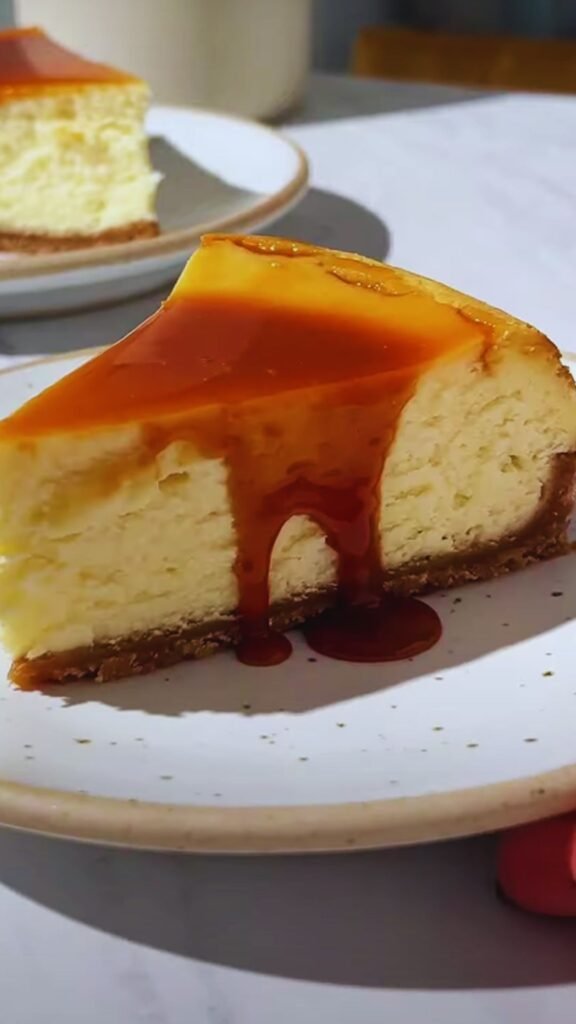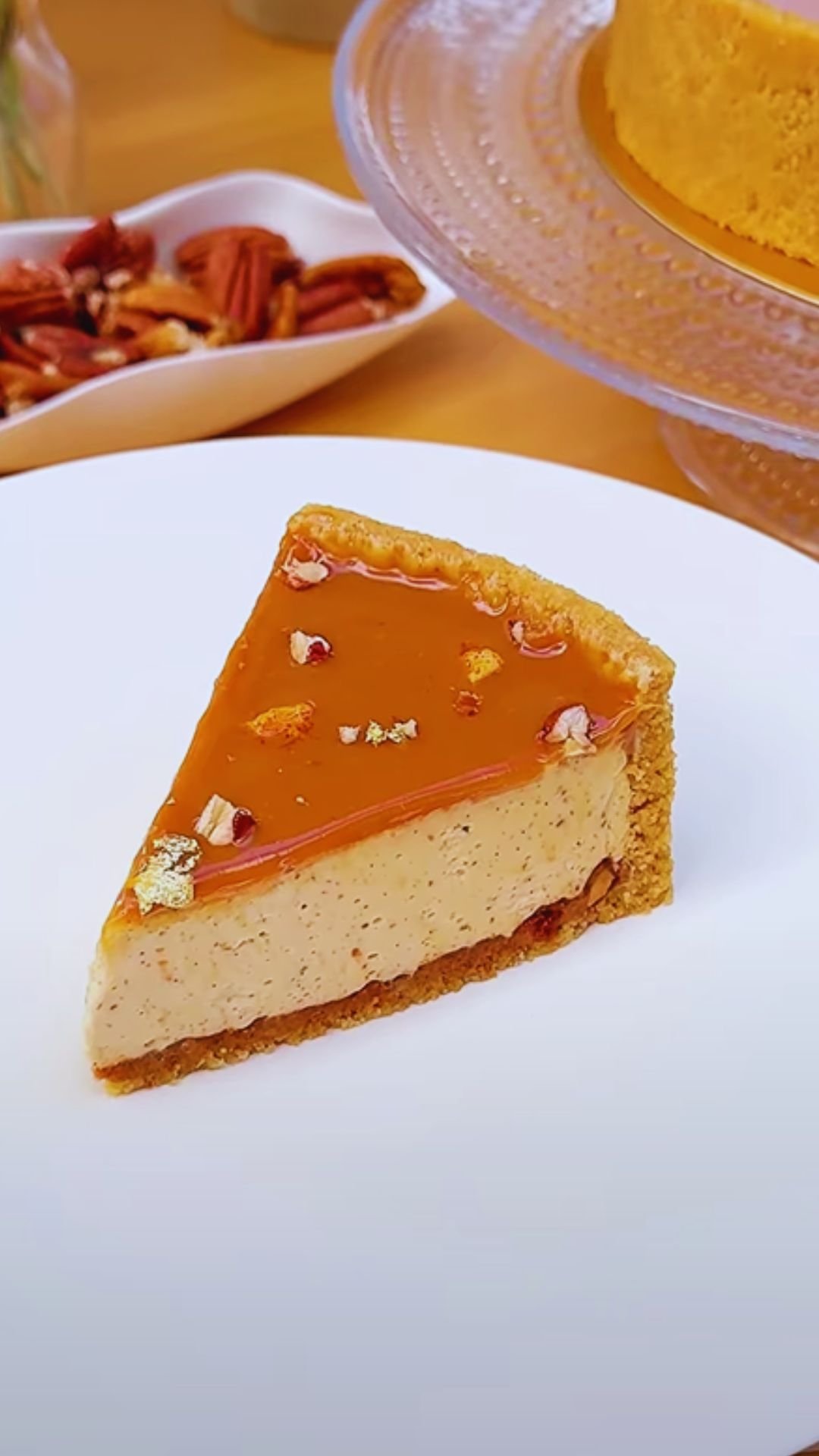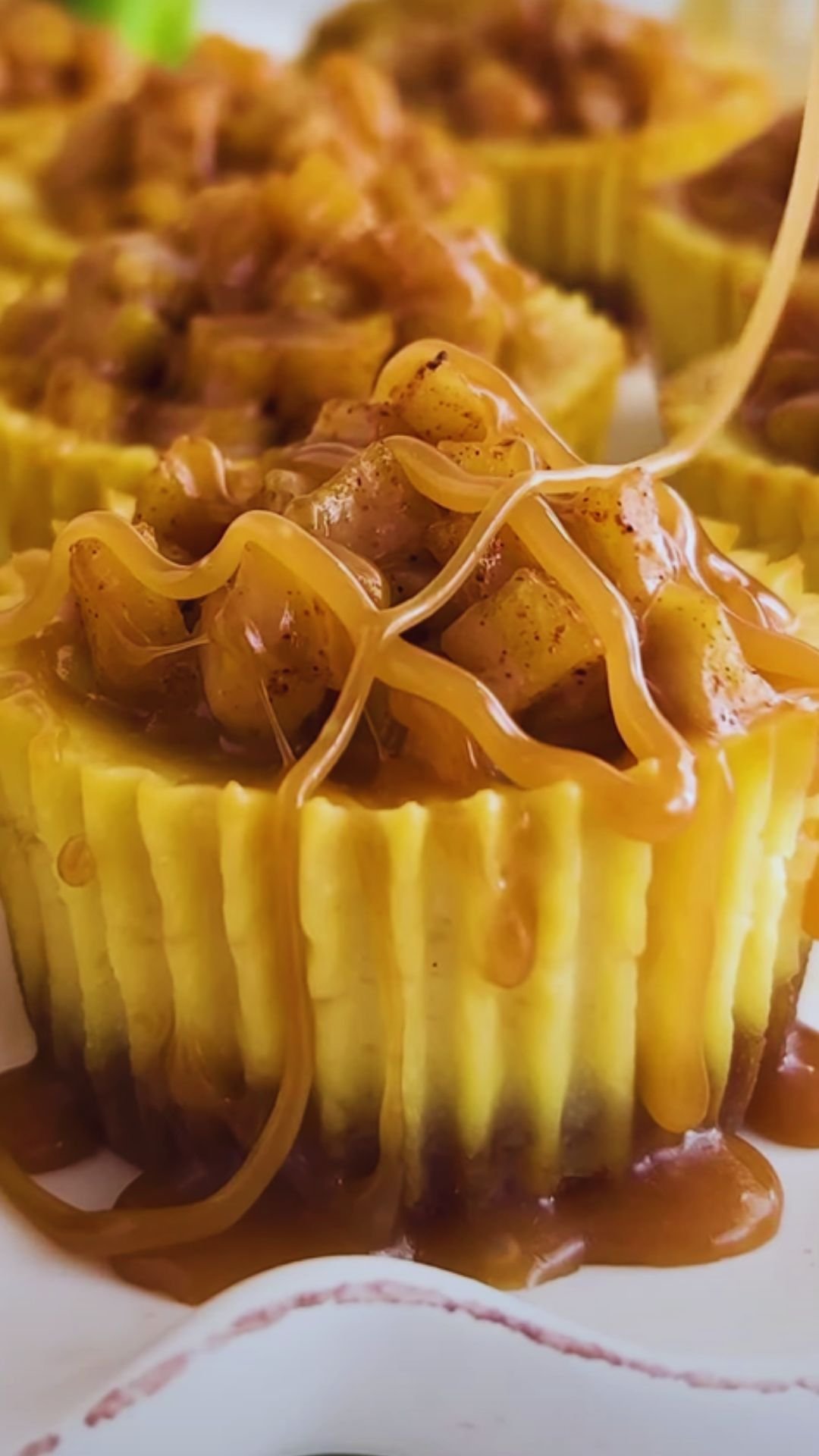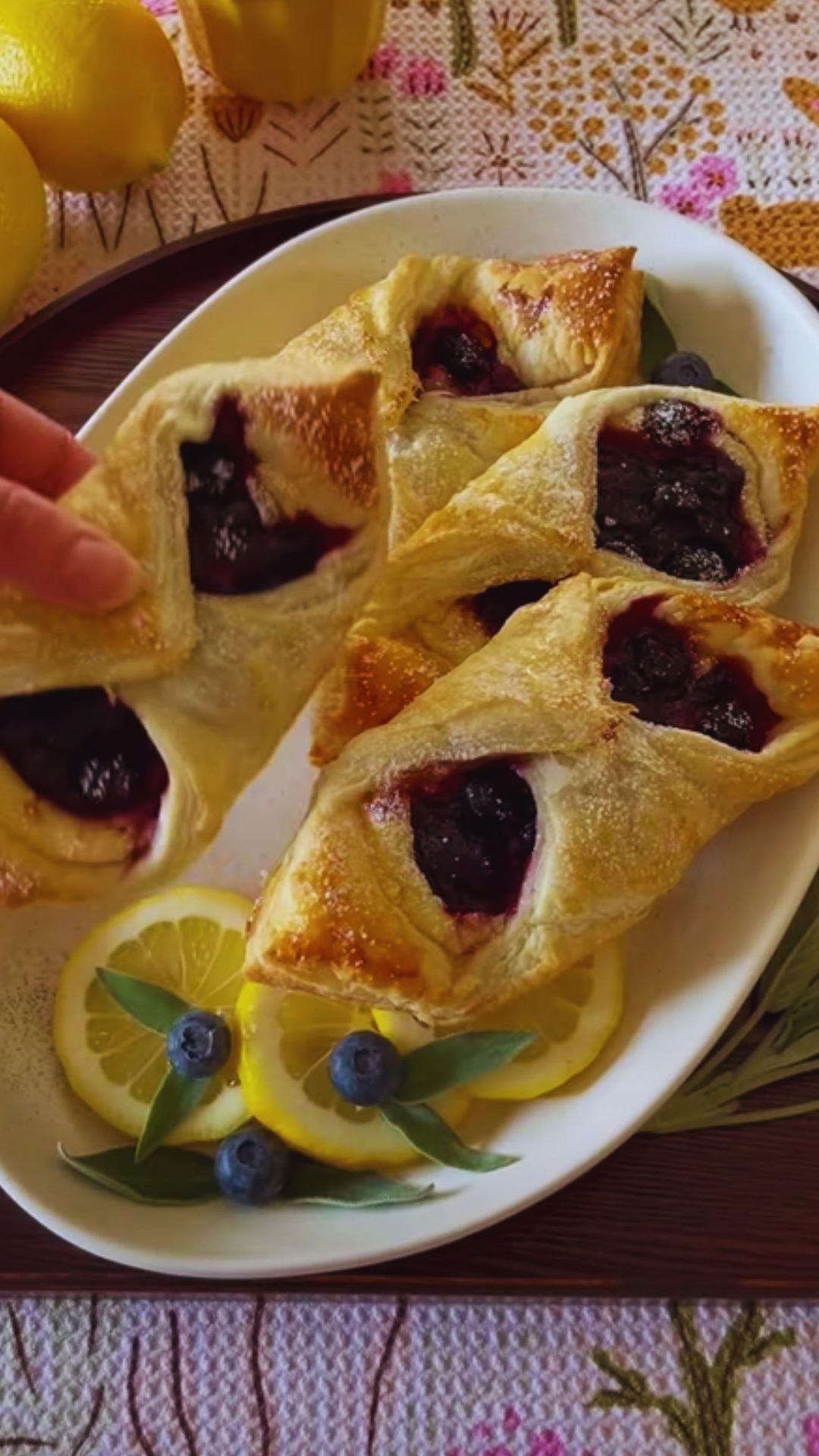There’s something magical about the first bite of a perfectly crafted caramel cheesecake. The silky smooth texture, the rich buttery notes of caramel, and that perfect balance of sweetness that dances on your taste buds. I’ve spent years perfecting my caramel cheesecake recipe, and today, I’m thrilled to share it with you—along with all my hard-earned tips and secrets.
What Makes Caramel Cheesecake Special
Caramel cheesecake isn’t just another dessert; it’s an experience. The combination of velvety cream cheese filling infused with caramel, sitting atop a buttery graham cracker crust, and topped with a glossy caramel sauce creates a harmony of flavors and textures that few desserts can match.
I remember the first time I made caramel cheesecake for my family gathering. The looks of pure bliss as everyone took their first bite made all the effort worthwhile. Since then, it’s become my signature dessert, requested at nearly every celebration.
The Science Behind Perfect Cheesecake
Before diving into the recipe, let’s understand what makes a cheesecake truly exceptional. Cheesecake success hinges on a few scientific principles:
Temperature Control : All ingredients should be at room temperature before mixing. This ensures proper incorporation and prevents lumps.
Gentle Mixing : Overmixing incorporates too much air, which can lead to cracks during baking.
Water Bath : Baking in a water bath provides gentle, even heat and adds necessary humidity to prevent cracking.
Slow Cooling : Gradual temperature changes prevent the dreaded center collapse and cracking.
Understanding these principles has transformed my cheesecake game from good to professional quality. Trust me, following these rules makes all the difference.
Essential Ingredients for Caramel Cheesecake
The quality of your ingredients directly affects the final result. Here’s what you’ll need for an unforgettable caramel cheesecake:
For the Crust
- 2 cups graham cracker crumbs (about 16 full sheets)
- 1/4 cup granulated sugar
- 1/2 cup unsalted butter, melted
- 1/2 teaspoon salt
For the Cheesecake Filling
- 32 ounces (4 blocks) cream cheese, softened
- 1 cup granulated sugar
- 1/2 cup caramel sauce (homemade or store-bought)
- 1 tablespoon vanilla extract
- 4 large eggs, room temperature
- 2 large egg yolks, room temperature
- 1/4 cup heavy cream
- 2 tablespoons all-purpose flour
For the Caramel Sauce
- 1 cup granulated sugar
- 1/4 cup water
- 4 tablespoons unsalted butter
- 1/2 cup heavy cream
- 1/2 teaspoon salt
- 1 teaspoon vanilla extract
For the Topping (Optional)
- 1/2 cup heavy cream
- 2 tablespoons powdered sugar
- Sea salt flakes for garnish
Equipment You’ll Need
Having the right tools makes the process smoother:
- 9-inch springform pan
- Large roasting pan (for water bath)
- Electric mixer (stand or hand)
- Aluminum foil
- Food processor (for graham crackers)
- Measuring cups and spoons
- Rubber spatula
- Mixing bowls
- Cooling rack

Detailed Step-by-Step Instructions
Preparation (Day Before)
- Take cream cheese, eggs, and heavy cream out of the refrigerator at least 2 hours before baking.
- Prepare your springform pan by lightly greasing it with butter.
- Preheat your oven to 325°F (165°C).
Making the Crust
- In a food processor, pulse graham crackers until finely ground.
- In a bowl, combine graham cracker crumbs, sugar, and salt.
- Pour in melted butter and mix until the mixture resembles wet sand.
- Press the mixture firmly into the bottom and slightly up the sides of your springform pan.
- Bake for 10 minutes, then cool completely on a wire rack.
Homemade Caramel Sauce
Creating your own caramel sauce elevates your cheesecake to new heights:
- In a heavy-bottomed saucepan, combine sugar and water. Heat over medium heat without stirring.
- When the mixture turns amber (about 8-10 minutes), remove from heat.
- Carefully add butter (it will bubble vigorously) and whisk until melted.
- Slowly pour in heavy cream while whisking constantly.
- Add salt and vanilla, then let the sauce cool to room temperature.
This makes more sauce than needed for the cheesecake, but trust me, you’ll want extra for drizzling!
Creating the Cheesecake Filling
- In a large bowl, beat cream cheese on medium speed until completely smooth, about 4 minutes.
- Add sugar and beat for another 2 minutes until well incorporated.
- Mix in 1/2 cup of your caramel sauce and vanilla extract.
- Add eggs and egg yolks one at a time, mixing just until each is incorporated.
- Pour in heavy cream and mix gently.
- Sift flour over the mixture and fold in carefully with a rubber spatula.
Assembly and Baking
- Wrap the outside of your springform pan with two layers of heavy-duty aluminum foil, ensuring it comes up the sides.
- Pour the filling over the cooled crust.
- Place the springform pan in a large roasting pan.
- Pour hot water into the roasting pan to reach halfway up the sides of the springform pan.
- Bake at 325°F (165°C) for 70-80 minutes, until the edges are set but the center still has a slight jiggle.
- Turn off the oven, crack the door open, and let the cheesecake cool in the oven for 1 hour.
- Remove from the oven and water bath, run a knife around the edges, and cool completely on a wire rack.
- Refrigerate for at least 6 hours, preferably overnight.
The Finishing Touches
- Before serving, prepare whipped cream by beating heavy cream with powdered sugar until soft peaks form.
- Remove cheesecake from the springform pan and place on a serving plate.
- Warm the remaining caramel sauce slightly and pour over the cheesecake, allowing it to drip down the sides.
- Pipe or spoon whipped cream around the edges.
- Sprinkle with sea salt flakes if desired.

Troubleshooting Common Issues
| Problem | Possible Cause | Solution |
|---|---|---|
| Cracked cheesecake | Overmixing or rapid temperature changes | Mix just until ingredients are incorporated; use water bath; cool slowly |
| Sunken center | Underbaking or opening oven door during baking | Bake until center has slight jiggle; avoid opening oven |
| Grainy texture | Cold ingredients or sugar not fully dissolved | Ensure all ingredients are room temperature; beat cream cheese thoroughly |
| Soggy crust | Moisture from water bath | Double wrap pan with foil; consider using a silicone water bath wrap |
| Lumpy filling | Cold cream cheese | Allow cream cheese to fully soften at room temperature (at least 2 hours) |
| Burnt caramel | Sugar heated too quickly or too high temperature | Use medium-low heat; swirl pan instead of stirring |
| Runny center | Underbaking | Extend baking time; center should jiggle slightly but not be liquid |
| Cheesecake sticks to pan | Pan not properly prepared | Lightly grease sides of springform pan before adding crust |
Flavor Variations to Experiment With
One thing I love about this recipe is its versatility. Here are some exciting variations to try:
Salted Caramel Chocolate Cheesecake
Add 1/2 cup melted dark chocolate to the filling and increase the salt in the caramel sauce to 1 teaspoon.
Bourbon Caramel Cheesecake
Add 2 tablespoons of good quality bourbon to both the filling and the caramel sauce.
Caramel Apple Cheesecake
Fold in 1 cup of sautéed cinnamon apples to the filling before baking.
Banoffee Caramel Cheesecake
Layer sliced bananas on the crust before adding the filling, and garnish with more banana slices.
Make-Ahead and Storage Tips
Cheesecake is the perfect make-ahead dessert:
- Make 1-2 days ahead: Cheesecake actually improves after 24 hours in the refrigerator as flavors meld.
- Refrigeration: Cover and store in the refrigerator for up to 5 days.
- Freezing: Wrap individual slices or the whole cheesecake (without toppings) in plastic wrap and then aluminum foil. Freeze for up to 3 months. Thaw overnight in the refrigerator.
- Caramel sauce: Store leftover sauce in an airtight jar in the refrigerator for up to 2 weeks. Reheat gently before using.

Nutritional Information
For those keeping track of dietary information, here’s the approximate nutritional breakdown per slice (assuming 12 slices):
| Nutrient | Amount per Serving |
|---|---|
| Calories | 580 |
| Total Fat | 42g |
| Saturated Fat | 25g |
| Cholesterol | 215mg |
| Sodium | 410mg |
| Total Carbohydrates | 46g |
| Dietary Fiber | 1g |
| Sugars | 38g |
| Protein | 8g |
| Calcium | 120mg |
| Iron | 1mg |
Serving Suggestions
The way you present your caramel cheesecake can elevate the entire experience:
- Temperature: Remove from refrigerator 30 minutes before serving to enhance flavors.
- Accompaniments: Serve with fresh berries, banana slices, or chopped nuts for textural contrast.
- Coffee pairing: A rich espresso or French press coffee balances the sweetness perfectly.
- Tea pairing: Earl Grey or chai tea complements the caramel notes beautifully.
- Cold drinks: Milk, almond milk, or a glass of sparkling water with lemon cuts through the richness.
Special Occasion Adaptations
Caramel cheesecake makes a stunning centerpiece for celebrations:
Birthday Cheesecake
Add colorful sprinkles to the crust mixture and top with candles before serving.
Holiday Version
Add 1 teaspoon of cinnamon, 1/2 teaspoon nutmeg, and 1/4 teaspoon cloves to the crust for a warming holiday flavor. Garnish with sugared cranberries.
Wedding Dessert
Make mini versions in muffin tins with shortened baking time (about 20-25 minutes) for an elegant dessert table option.
Frequently Asked Questions
Q: Can I make this cheesecake without a springform pan? A: While a springform pan is ideal, you can use a regular cake pan lined with parchment paper with extra overhang to help lift the cheesecake out after cooling.
Q: Why did my caramel crystallize and become grainy? A: This typically happens when sugar crystals form during the cooking process. Avoid stirring the caramel while it’s cooking—just swirl the pan gently. Also, make sure your pot is completely clean before starting.
Q: Can I use low-fat cream cheese? A: I don’t recommend it. Full-fat cream cheese provides the rich, creamy texture that makes cheesecake special. Low-fat versions often contain more water and stabilizers that affect the final texture.
Q: How do I know when my cheesecake is done baking? A: The outer 2-3 inches should be set but the center should still have a slight jiggle (not a liquid wobble). It will continue to set as it cools.
Q: Can I skip the water bath? A: The water bath helps prevent cracking and ensures even baking. If you skip it, your cheesecake might crack or become too dry. As an alternative, you can place a pan of water on the rack below your cheesecake.
Q: What if I don’t have time for overnight chilling? A: A minimum of 4 hours is required, but the texture and flavor improve significantly with longer chilling. For emergency cooling, place in the freezer for 1-2 hours after it has reached room temperature.
Q: Can I make this recipe gluten-free? A: Yes! Use gluten-free graham crackers for the crust and substitute the flour in the filling with 1 tablespoon of cornstarch.
Q: Why does my cheesecake always crack? A: Cheesecakes typically crack from overmixing (which incorporates too much air), baking at too high a temperature, or cooling too quickly. Follow the slow mixing and cooling instructions carefully to prevent this.
A Personal Note
I’ve made this caramel cheesecake recipe dozens of times over the years, tweaking and adjusting until reaching this perfect version. The recipe might seem complex at first glance, but I promise the effort is worthwhile. There’s something deeply satisfying about creating a dessert that brings such joy to others.
Remember that patience is key with cheesecake—from bringing ingredients to room temperature to the slow cooling process and overnight chilling. Each step contributes to that perfect texture and flavor that makes people close their eyes in bliss with the first bite.
Whether you’re making this for a special occasion or simply treating yourself after a long week, this caramel cheesecake is sure to become a favorite in your recipe collection, just as it has in mine.
Happy baking, and enjoy the sweet moments this cheesecake creates!


